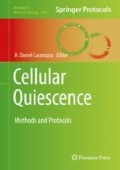Abstract
Naïve T cells are in a quiescent state under homeostasis but respond to antigen stimulation by exiting from quiescence and entering the cell cycle. Appropriate regulation of quiescence is crucial for maintaining T cell homeostasis at steady state and initiating proper T cell responses to antigen stimulation. Emerging evidence indicates that signaling by mechanistic target of rapamycin (mTOR) plays a central role in the control of T cell quiescence and antigen-induced exit from quiescence through coordinating immune signals, cellular metabolic programs, and cell cycle machinery. The mTOR-dependent regulation of quiescence has also been implicated in the differentiation and function of memory T cells. In this chapter, we describe techniques to assess quiescent state of naïve T cells under steady state and exit from quiescence upon TCR stimulation.
Access this chapter
Tax calculation will be finalised at checkout
Purchases are for personal use only
References
Takada K, Jameson SC (2009) Naive T cell homeostasis: from awareness of space to a sense of place. Nat Rev Immunol 9(12):823–832. doi:10.1038/nri2657
Yang K, Chi H (2012) mTOR and metabolic pathways in T cell quiescence and functional activation. Semin Immunol 24(6):421–428. doi:10.1016/j.smim.2012.12.004
Hamilton SE, Jameson SC (2012) CD8 T cell quiescence revisited. Trends Immunol 33(5):224–230. doi:10.1016/j.it.2012.01.007
MacIver NJ, Michalek RD, Rathmell JC (2013) Metabolic regulation of T lymphocytes. Annu Rev Immunol 31:259–283. doi:10.1146/annurev-immunol-032712-095956
Sena LA, Li S, Jairaman A, Prakriya M, Ezponda T, Hildeman DA, Wang CR, Schumacker PT, Licht JD, Perlman H, Bryce PJ, Chandel NS (2013) Mitochondria are required for antigen-specific T cell activation through reactive oxygen species signaling. Immunity 38(2):225–236. doi:10.1016/j.immuni.2012.10.020
Buck MD, O'Sullivan D, Pearce EL (2015) T cell metabolism drives immunity. J Exp Med 212(9):1345–1360. doi:10.1084/jem.20151159
Yang K, Neale G, Green DR, He W, Chi H (2011) The tumor suppressor Tsc1 enforces quiescence of naive T cells to promote immune homeostasis and function. Nat Immunol 12(9):888–897. doi:10.1038/ni.2068
Wu Q, Liu Y, Chen C, Ikenoue T, Qiao Y, Li CS, Li W, Guan KL, Liu Y, Zheng P (2011) The tuberous sclerosis complex-mammalian target of rapamycin pathway maintains the quiescence and survival of naive T cells. J Immunol 187(3):1106–1112. doi:10.4049/jimmunol.1003968
Yang K, Shrestha S, Zeng H, Karmaus PW, Neale G, Vogel P, Guertin DA, Lamb RF, Chi H (2013) T cell exit from quiescence and differentiation into Th2 cells depend on raptor-mTORC1-mediated metabolic reprogramming. Immunity 39(6):1043–1056. doi:10.1016/j.immuni.2013.09.015
Kidani Y, Elsaesser H, Hock MB, Vergnes L, Williams KJ, Argus JP, Marbois BN, Komisopoulou E, Wilson EB, Osborne TF, Graeber TG, Reue K, Brooks DG, Bensinger SJ (2013) Sterol regulatory element-binding proteins are essential for the metabolic programming of effector T cells and adaptive immunity. Nat Immunol 14(5):489–499. doi:10.1038/ni.2570
Chi H (2012) Regulation and function of mTOR signalling in T cell fate decisions. Nat Rev Immunol 12(5):325–338. doi:10.1038/nri3198
Zeng H, Yang K, Cloer C, Neale G, Vogel P, Chi H (2013) mTORC1 couples immune signals and metabolic programming to establish T(reg)-cell function. Nature 499(7459):485–490. doi:10.1038/nature12297
Delgoffe GM, Pollizzi KN, Waickman AT, Heikamp E, Meyers DJ, Horton MR, Xiao B, Worley PF, Powell JD (2011) The kinase mTOR regulates the differentiation of helper T cells through the selective activation of signaling by mTORC1 and mTORC2. Nat Immunol 12(4):295–303. doi:10.1038/ni.2005
Lee K, Nam KT, Cho SH, Gudapati P, Hwang Y, Park DS, Potter R, Chen J, Volanakis E, Boothby M (2012) Vital roles of mTOR complex 2 in notch-driven thymocyte differentiation and leukemia. J Exp Med 209(4):713–728. doi:10.1084/jem.20111470
Zeng H, Cohen S, Guy C, Shrestha S, Neale G, Brown SA, Cloer C, Kishton RJ, Gao X, Youngblood B, Do M, Li MO, Locasale JW, Rathmell JC, Chi H (2016) mTORC1 and mTORC2 kinase signaling and glucose metabolism drive follicular helper T cell differentiation. Immunity 45(3):540–554. doi:10.1016/j.immuni.2016.08.017
Kurebayashi Y, Nagai S, Ikejiri A, Ohtani M, Ichiyama K, Baba Y, Yamada T, Egami S, Hoshii T, Hirao A, Matsuda S, Koyasu S (2012) PI3K-Akt-mTORC1-S6K1/2 axis controls Th17 differentiation by regulating Gfi1 expression and nuclear translocation of RORgamma. Cell Rep 1(4):360–373. doi:10.1016/j.celrep.2012.02.007
Acknowledgments
The authors acknowledge H. Zeng and Y. Wang for scientific inputs and editing. This work was supported by NIH AI105887, AI101407, CA176624 and NS064599, and American Asthma Foundation.
Author information
Authors and Affiliations
Corresponding author
Editor information
Editors and Affiliations
Rights and permissions
Copyright information
© 2018 Springer Science+Business Media LLC
About this protocol
Cite this protocol
Yang, K., Chi, H. (2018). Investigating Cellular Quiescence of T Lymphocytes and Antigen-Induced Exit from Quiescence. In: Lacorazza, H. (eds) Cellular Quiescence. Methods in Molecular Biology, vol 1686. Humana Press, New York, NY. https://doi.org/10.1007/978-1-4939-7371-2_12
Download citation
DOI: https://doi.org/10.1007/978-1-4939-7371-2_12
Published:
Publisher Name: Humana Press, New York, NY
Print ISBN: 978-1-4939-7370-5
Online ISBN: 978-1-4939-7371-2
eBook Packages: Springer Protocols

